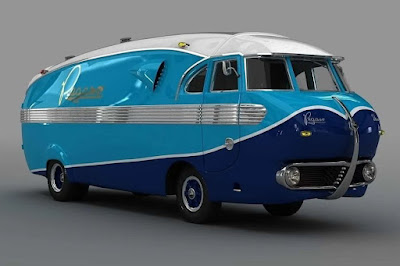Forgotten ONES - Transporter vehicles often go unnoticed in the world of motorsport, yet they play a crucial role. These carriers ensure race cars arrive at their destinations safely and in style. In previous discussions, we delved into the 1955 Mercedes-Benz Race Team Transporter and the 1961 Cheetah Race Car Transporter. Today, let's explore an intriguing model from Spain, a country with a rich history in vehicle manufacturing, despite its relatively low profile in the global automotive industry.
 |
| The Pegaso Z-902 'Bacalao', a rare 1952 Spanish racing car transport vehicle, has been immortalized in diecast form. (Picture from: QuirkyRides's status on X) |
Spain has produced a wide variety of vehicles, from passenger cars to trucks and motorcycles. Among these, the now-defunct Pegaso brand stands out, especially for its unique sportscars based on the Pegaso Z-102, such as the Cúpula from 1952 and the "Bisiluro" 1A Serie from 1953. Interestingly, Pegaso also ventured into the realm of transporter vehicles. One notable model is the Pegaso Z-902 'Bacalao', a sports vehicle transport truck of 1952 named at the La Sagrera factory in Barcelona.
 |
| The name 'Bacalao' is unofficial and refers to the design, which resembles the lateral gills of a codfish, known as bacalao in Spanish. (Picture from: es.Motor1) |
The Pegaso Z-902 'Bacalao' was a familiar sight on Spanish roads from 1952 until 1970. Officially, only one unit was produced, although rumors suggest there might have been two, even more. This transporter was based on the Z-401 bus, with bodywork crafted by Carde y Escoriaza. Initially painted white and powered by a 145 hp gasoline engine, it was soon fitted with a six-cylinder diesel engine, likely producing 125 hp. The exterior colors were also updated over time.
 |
| The Pegaso Z-902 'Bacalao' was based on the Z-401 bus, featuring bodywork crafted by Carde y Escoriaza. (Picture from: es.Motor1) |
One of the most striking features of the Pegaso Z-902 'Bacalao' was its unique body, measuring 11.0 meters long and 3.5 meters high, capable of carrying a couple of cars and some equipment. However, it typically transported just one vehicle along with a significant number of spare parts. The driver’s seat was centrally located above the engine, surrounded by seven windows, and the controls were somewhat unconventional. The handbrake and gearbox lever were on the left, while the gearbox itself was mounted on the steering stem, requiring drivers to adapt.
 |
| The Pegaso Z-902 'Bacalao' was a familiar sight on Spanish roads from 1952 until 1970, with only one officially produced unit, though rumors suggest there might have been more. (Picture from: es.Motor1) |
The cargo compartment of the 'Bacalao' featured a wooden floor, a small sink with a water tank, and a tool drawer. Notably, it had the lights from 1060 truck, including a green light that indicated safe overtaking opportunities. After being showcased in Madrid and Barcelona, the 'Bacalao' was used to transport and provide technical assistance for Pegaso Z-102 sports cars during training for the 1953 24 Hours of Le Mans.
 |
| One of the most striking features of the Pegaso Z-902 'Bacalao' was its unique 11.0-meter long, 3.5-meter high body, capable of carrying two cars and equipment. (Picture from: es.Motor1) |
 |
| The cargo compartment of the Pegaso Z-902 'Bacalao' included a wooden floor, a small sink with a water tank, and a tool drawer. (Picture from: es.Motor1) |
 |
| After being showcased in Madrid and Barcelona, the Pegaso Z-902 'Bacalao' transported and provided technical assistance for Pegaso Z-102 sports cars during training for the 1953 24 Hours of Le Mans. (Picture from: es.Motor1) |
This unique vehicle, nicknamed 'Bacalao' or 'Codfish in English' for its lateral gill-like design, was initially immortalized by Modeltrans for a select few collectors and later 'democratized' by Salvat through its Pegaso model collection. The model stands out for its excellent finishes, fully metallic body (except for the rear doors), and detailed paint job, complete with ramps, historical license plates, and an accurate interior.
 In conclusion, the Pegaso Z-902 'Bacalao' is a testament to the creativity and engineering prowess of the Spanish automotive industry. Its story, from its days of glory to its eventual decline, reflects a unique chapter in the history of vehicle transporters, leaving behind a legacy that continues to fascinate enthusiasts and collectors alike. *** [EKA | FROM VARIOUS SOURCES | ES.MOTOR1 | QUIRKYRIDES | ES.WIKIPEDIA | AUTOPIONEER.DE | DANNATA-VINTAGE | TBSLOT | PINTEREST ]
In conclusion, the Pegaso Z-902 'Bacalao' is a testament to the creativity and engineering prowess of the Spanish automotive industry. Its story, from its days of glory to its eventual decline, reflects a unique chapter in the history of vehicle transporters, leaving behind a legacy that continues to fascinate enthusiasts and collectors alike. *** [EKA | FROM VARIOUS SOURCES | ES.MOTOR1 | QUIRKYRIDES | ES.WIKIPEDIA | AUTOPIONEER.DE | DANNATA-VINTAGE | TBSLOT | PINTEREST ]Note: This blog can be accessed via your smart phone


 Logging you in...
Logging you in...